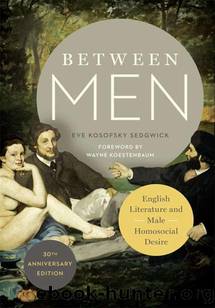Between Men (Gender and Culture Series) by Eve Kosofsky Sedgwick

Author:Eve Kosofsky Sedgwick [Sedgwick, Eve Kosofsky]
Language: eng
Format: epub
Tags: LIT004160, Literary Criticism/Gay and Lesbian, LIT004130, Literary Criticism/European/General
Publisher: Columbia University Press
Published: 2015-11-24T00:00:00+00:00
As I have already suggested, I consider it likely that the main subject of the âparanoidâ classic Gothic as a whole can best be described in the terms I have been using for Hoggâs novel. Some criticism has discussed how close the preoccupation with doubles and with persecution in these novels is to something (today) recognizably like male homosexual thematics.10 What I wish to emphasize, by contrast, is the focus on homophobia as a tool of control over the entire spectrum of male homosocial organization. This emphasis seems potentially more precise and revealing. Most broadly, it allows us to read these novels as explorations of social and gender constitution as a whole, rather than of the internal psychology of a few individual men with a âminorityâ sexual orientation. There are several concomitant advantages to this. First, it gives us more, and more interesting, terms for discussing the positions of women in these novels and the societies they portray. Second, the âevidentialâ questions associated with any literary-critical discussionânever mind a historical oneâof individual male homosexuality have most often been couched in peculiarly unilluminating terms, as of accusation and defense.11 Aside from the inappropriateness of these adversarial terms for the discussion of fictional characters and preoccupations, and apart even from the unacceptably homophobic, and evidentially distorting, assumptions that underlie the treatment of homosexuality as an accusation, the legalistic frame of discussion of ascribed homosexuality disguises or denies the importance of much more fundamental and entirely unanswered questions about the constitution and social meaning of male homosexuality itself.
If there is a loss or a danger in my shift of emphasis from the homosexual to the homophobic content of the Gothic, it would lie in the potential blurring, the premature âuniversalization,â of what might prove to be a distinctly homosexual, minority literary heritage. Feminist critics have long understood that when the male-centered critical tradition has bestowed the tribute of âuniversalityâ on a womanâs writing, it is often not an affirmation but rather a denial of the sources of her writing in her own, female specificity. The extra virulence of racism in our culture has minimized the danger of this particular spurious naturalization of the work of writers of color, but the ambiguous, prestigious spectre of âuniversalityâ has nevertheless exerted a structuring and sometimes divisive effect on the history of at any rate Black American culture. Similarly, a premature recuperation (as being about the entire range of social gender constitution) of a thematic array that might in the first place have a special meaning for homosexual men as a distinctively oppressed groupâwhich, beyond the reach of any unanswered questions, they unmistakably do constitute in our society as it isâwould risk cultural imperialism.
Still, it is apt to be a critic able to read and speak as a participant in gay male culture who can recognize and situate such thematic arrays most authoritatively.12 Obviously, I am not that critic. But also, interestingly, such critics have not so far been much attractedâat least in their writingsâto the Gothic
Download
This site does not store any files on its server. We only index and link to content provided by other sites. Please contact the content providers to delete copyright contents if any and email us, we'll remove relevant links or contents immediately.
Professional Troublemaker by Luvvie Ajayi Jones(29591)
Whiskey Words & a Shovel I by r.h. Sin(19302)
Rewire Your Anxious Brain by Catherine M. Pittman(18555)
Healthy Aging For Dummies by Brent Agin & Sharon Perkins RN(17003)
Cat's cradle by Kurt Vonnegut(15191)
Talking to Strangers by Malcolm Gladwell(13235)
The Art of Thinking Clearly by Rolf Dobelli(10234)
They Both Die at the End by Adam Silvera(9724)
The 5 Love Languages: The Secret to Love That Lasts by Gary Chapman(9607)
Doing It: Let's Talk About Sex... by Hannah Witton(9198)
The Compound Effect by Darren Hardy(8821)
Thirteen Reasons Why by Jay Asher(8801)
Goodbye, Things by Fumio Sasaki(8482)
Wonder by R.J. Palacio(8470)
Tools of Titans by Timothy Ferriss(8230)
Atomic Habits: Tiny Changes, Remarkable Results by James Clear(8188)
Becoming Supernatural by Dr. Joe Dispenza(8127)
Wonder by R. J. Palacio(8014)
Change Your Questions, Change Your Life by Marilee Adams(7641)
